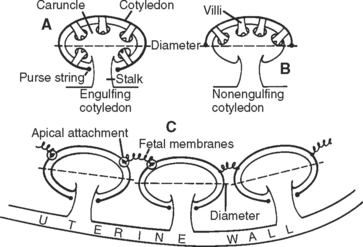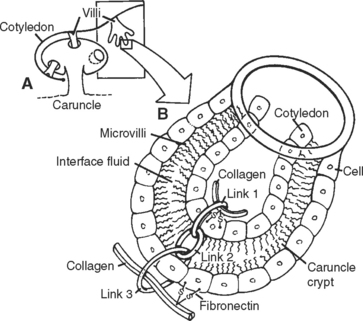CHAPTER 45 Retained Placenta
DEFINITION
Physiologic versus Pathologic Retention
Theoretically, all cows that calve have retained fetal membranes (RFM). Greater than three fourths of cows, however, expel their placenta by 6 hours, and very few cows after 12 hours post partum (Table 45-1). Detrimental effects on reproductive performance, milk production, postpartum disease, and culling rate were detected when duration of retention exceeded 12 hours (Table 45-2). For fourth parity and higher, the cows’ overall performance was best with expulsion of the placenta within 6 hours post partum. For this reason, it has been proposed that, in older cows, retained placenta is a failure to expel placenta within 6 hours after parturition. Heifers that expelled their placentas within 6 hours after calving had the lowest incidence of mastitis occurring within 1 week after calving. Because the incidence rates of RFM and postpartum disease vary with parity, the definition of retained placenta also may be age-dependent or parity-dependent. Periods from 8 to 48 hours have been proposed by various authors, but 12 hours is a widely used lapse to define RFM.
Table 45-1 Timing of Placental Expulsion after Parturition*
| Hours Postpartum | % of Cumulative Expulsions |
|---|---|
| 3 | 16.0 |
| 6 | 77.3 |
| 9 | 88.7 |
| 12 | 94.6 |
| 15 | 96.2 |
| 18 | 97.8 |
| 21 | 98.5 |
| 24 | 100.0 |
* During 3-hour time intervals. N = 871. Only cows expelling placentas by 24 hours or less were included. Values are approximate.
Data from van Werven T, et al: Theriogenology 1992;37:1991.
Table 45-2 Biomedical Effects of Pathologic Retention of Fetal Membranes in Cows
| Factor | Change* |
|---|---|
| Physiologic | |
| Appetite | Decreased in 60% of cows |
| Uterine involution | Delayed 11 days |
| Uterine chemotaxis | Decreased |
| Uterine immunity | Decreased |
| Milk volume secreted | (0) % to (−) 2% |
| Milk chemistry | Fat, protein unchanged |
| Uterine bacteria | Increased |
| Reproductive Management | |
| Return to heat | Delayed 17 d, 19 d |
| Number of inseminations | (+) 15% |
| Conception rate | (−) 11%, (−) 19% |
| Calving interval | (+) 10 d, (+) 19 d, (+) 20 d |
| Culling rate | (+) 5.2%, (+) 7.9%, (+) 10.5% |
| Milk production | (−) 207 kg, (−) 200 kg, (−) 168 kg |
| Days open | (+) 26 d, (+) 31 d |
| Overall performance | Best when retention is less than 6–12 h |
| Health-related | |
| Metritis | (+) 18%, (+) 23%, (+) 28%, (+) 53% |
| Lochiometra | (+) 20% |
| Mastitis | (0) %, (+) 5.8%, (+) 10%, (+) 15% |
| Previous retention | (+) correlation |
| Cystic ovary | (+) 0%, (+) 15%, (+) 50% |
| Ketosis | (0), (+) correlation |
| Epidemiologic | |
| Incidence | Average 7.5% (2–55%) |
| Effect of season | (+) 2%, (+) 5%, (+) 12% summer |
| Effect of year (1976–1983) | 1.6% curvilinear increase in 7-year period |
| Morbidity | 1.96–55% |
| Mortality | 1–4% |
| Effect of age/parity | Positive correlation |
(0) (+) (−), unchanged, increased, or decreased compared with cows without retained fetal membranes.
* Range or values reported by different researchers. Because of inconsistent experimental designs, data cannot be extrapolated between studies.
Duration of Pathologic Retention
In one series, spontaneous expulsion of retained membranes occurred between 5 and 7 days post partum in greater than one half (59%) of cows with RFM (Table 45-3). In a different experiment, however, when detachment was tested by manual traction on the membranes, they were found to be loose and “floating” in the uterus between 2 and 4 days post partum in 50% of cows with RFM. It seems that in some cows, a delay of 1 or 2 days may occur between detachment and expulsion of retained membranes. Delayed expulsion was more frequently observed in cows induced to deliver with dexamethasone (70%) than in cows with naturally occurring RFM (40%). Only 6% of the cows retained fetal membranes for 2 weeks or more. A mean retention duration of 6.8 days (range, 2–11 days) was reported. Distribution of the values for duration of retained placenta was reported to be bimodal, with a first peak at day 3 post partum and a second peak by day 7. One explanation for the bimodal distribution in expulsion of RFM is that cotyledon proteolysis was the detachment mechanism by day 3, and caruncle necrosis by day 7 post partum.
Table 45-3 Duration of Retention*
| Retention (d) | % Expelled (Cumulative %) | % Retraction (Cumulative %) |
|---|---|---|
| 2–4 | 32 (32) | 50 (50) |
| 5–7 | 27 (59) | 38 (88) |
| 8–10 | 28 (87) | 8 (96) |
| 11–13 | 7 (94) | 4 (100) |
| 14–17 | 6 (100) | — |
* Estimated by either spontaneous expulsion of membranes or manual retraction of hanging membranes.
Adapted from van Werven T, et al: Theriogenology 1992;37:1191; and Eiler H, Hopkins FM: Successful treatment of retained placenta with umbilical cord injections of collagenase in cows. J Am Vet Med Assoc 1993;203:436.
EPIDEMIOLOGY
Incidence, morbidity, and mortality rates are shown in Table 45-2. An average incidence frequently reported for a relatively large number of calvings has been shown to range from 4% to 11%. A comprehensive study of about 369,000 calvings showed the incidence of RFM to be 6.6% after all births and 4.1% after normal deliveries only. Risk factors that are known to affect incidence rates are listed in Table 45-4. Notice the high risk factor values in conditions in which both physical damage to the uterus was inflicted and hormone imbalances were induced. Also of interest is that eradication of brucellosis did not statistically decrease RFM incidence.
Table 45-4 Association of Obstetric, Physiologic, Hormonal, Nutritional, and Infectious Factors with Retained Placenta in the Bovine
| Factor | % Retained Placenta | Relative Risk* |
|---|---|---|
| Obstetric | ||
| Abortion | 62 | 10.3 |
| Multiple birth | 37 | 8.3 |
| Two previous retentions | 25 | 6.0 |
| Cesarean delivery in hospital | 62 | 6.0 |
| Stillbirth | 19 | 4.4 |
| Fetotomy | 26 | 4.1 |
| Advanced age of cow | 10 | 3.3 |
| Cesarean delivery | 26 | 3.2 |
| One previous retention | 12 | 3.0 |
| Difficult calving | 13 | 2.1 |
| Physiologic | ||
| Short gestation plus low calf weight | 12 | 3.0 |
| Summer calvings | 11 | 1.6 |
| Sex of calf (male) | 1.05 | |
| Hormone Imbalance | ||
| Prepartum ovariectomy | 100 | 15.1 |
| Prepartum corpus luteum ablation | 100 | 15.1 |
| Abnormal (high/low) prepartum | ||
| Progesterone | 90 | 13.6 |
| Estrogens | 34 | 5.1 |
| Induced delivery | ||
| Prostaglandin F2α | 80 | 12.1 |
| Dexamethasone + prostaglandin F2α | 79 | 12.0 |
| Dexamethasone | 67 | 10.1 |
| Dexamethasone + estrogens | 67 | 10.1 |
| Dexamethasone + relaxin | 15 | 2.2 |
| Nutritional | ||
| Selenium/vitamin E deficiency | 23 | 2.4 |
| Feeding hay crop/corn silage | 28 | 1.8 |
| Excess iron | 16 | 1.5 |
| Infectious | ||
| Brucellosis-positive status of cows | 28 | 3.0 |
* Calculated by dividing the proportion of cows with the factor of interest (column 1) that caused retained placenta by the proportion of cows without the factor. An error in the estimates is possible owing to variation in experimental designs.
ECONOMICS
In a study conducted in The Netherlands with 160,000 calvings, the relative economic impact expressed in percentage was identified in four main areas: decreased milk production (40%), increased veterinary services (32%), increased culling rate (19%), and increased calving interval (9%). In other studies in Holsteins in the Northeast United States and in Ayrshires from Finland, however, retained placenta had a significant effect on milk yield. For example, it was calculated that second-parity cows decreased milk production by 1.4 kg/day as a result of retained placenta. In these same studies, it also was estimated that retained placenta lowered conception rate by 14%, compared with that in cows free of this disorder.1
ETIOLOGY
Detachment of the fetal membranes indicates that uterine involution is progressing normally. Involution of the uterus is accompanied by a massive breakdown of collagen and other proteins. Lack of cotyledon proteolysis (collagenolysis) appears to be the underlying cause of RFM. If placenta-anchoring systems are not enzymatically degraded, fetal membranes are retained. Analysis of risk factors (see Table 45-4) may help to identify causes.
Anchoring Systems
The fetal cotyledon engulfs the maternal caruncle to form the primary anchoring system of the placenta, which keeps maternal and fetal tissues in apposition. Cotyledons form a cul-de-sac (pouch) that fits perfectly around the caruncle, and the open end simulates a purse-string closure (Fig. 45-1). Secondary anchoring mechanisms involve the rootlike penetration of caruncle crypts by cotyledon villi and the adhesive fluid present in the fetal-maternal interface (Fig. 45-2). The main function of the secondary anchoring mechanism is to hold together maternal and fetal epithelia within the placentome for physiologic exchange. By itself, the secondary anchoring mechanism seems to be capable of maintaining the fetal-maternal attachment throughout pregnancy, as observed in placentomes that are flat, without engulfment of the caruncle by the cotyledon (see Fig. 45-1).
Stay updated, free articles. Join our Telegram channel

Full access? Get Clinical Tree




